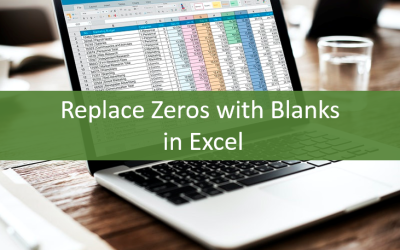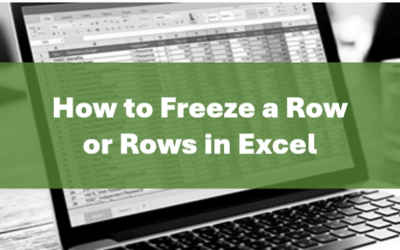Summarize Multiple Excel Worksheets Using 3D References in Formulas
by Avantix Learning Team | Updated January 24, 2021
Applies to: Microsoft® Excel® 2010, 2013, 2016, 2019 and 365 (Windows)
You can use 3D references in Excel formulas to summarize multiple worksheets that are structured in the same way. A 3D reference refers to the same cell or range of cells on multiple worksheets.
Recommended article: How to Enter Data in an Excel Filtered List into Visible Cells (2 Ways)
Do you want to learn more about Excel? Check out our virtual classroom or live classroom Excel courses >
Working with 3D references
Since a 3D reference refers to the same cell or range of cells on multiple worksheets, it references the cell or range of cells and also a range of worksheet names.
All of the worksheets you wish to reference must be set up the same way and use the same data types.
For example, if you want to create a total for product sales and extract data from January, February, March and April worksheets where the total is in cell B6 on all sheets, you could create the following formula:
=January!B6+February!B6+March!B6+April!B6
However, if you have 12 sheets for the year or even more sheets, you could end up with a fairly long formula.
As an alternative, you could use a 3D reference with the SUM function to total all of the sheets as in the following formula:
=SUM(January:April!B6)
You can also use ranges of cells as in the following 3D formula:
=SUM(January:April!B2:B5)
Syntax for 3D formulas
The syntax for a 3D formula is:
=Function(Firstsheet:Lastsheet!cell)
or
=Function(Firstsheet:Lastsheet!range)
When you are using 3D formulas in Excel, all worksheets between the first worksheet and the last worksheet are included in the formula.
Creating formulas with 3D references
To create a formula with a 3D reference:
- Click the cell where you want to enter a 3D formula (such as a cell on a summary worksheet).
- Type an equal sign (=), enter the function's name (such as SUM) and then type an open round bracket.
- Click the tab of the first worksheet that you want to include in the 3D reference.
- Press Shift and click the tab of the last worksheet that you want to include in the 3D reference.
- On the first worksheet, click the cell or drag over the range of cells that you want to include in the formula. The cell or cells must be in the same location on all sheets.
- Enter the remainder of the formula as required and a closed round bracket.
- Press Enter to complete the 3D formula. For example, =SUM(January:April!B6).
How 3D references update when you insert, move or delete worksheets
Because each 3D reference in Excel is defined by the starting and ending worksheet (the 3D reference end points), changing the end points changes the reference which then changes your 3D formula.
If you insert, copy or move worksheets between the starting and ending worksheet, the referenced range in all newly added sheets will be included in the 3D formula.
When you move any of the worksheets outside of the endpoints, these worksheets will be excluded from your 3D formula. If you move the ending worksheet to the start, or the starting worksheet to the end, the sheets will also be excluded.
If you restore the original order of the starting or ending worksheet, this will not restore the original 3D reference. You should recreate the formula.
When you delete the starting or ending worksheet, it is removed from the 3D reference and the deleted endpoint changes. If the first sheet is deleted, the end point changes to the sheet that follows it. If the last sheet is deleted, the end point changes to the preceding sheet.
Excel functions that allow 3D references
You can use 3D references with the following Excel functions:
SUM
AVERAGE
AVERAGEA
COUNT
COUNTA
MAX
MAXA
MIN
MINA
PRODUCT
STDEV, STDEVA, STDEVP and STDEVPA
VAR, VARA, VARP and VARPA
Formulas with 3D references are a great way to summarize the same cells or ranges from multiple sheets.
This article was first published on March 2, 2019 and has been updated for clarity and content.
Subscribe to get more articles like this one
Did you find this article helpful? If you would like to receive new articles, join our email list.
More resources
10 Great Excel Navigation Shortcuts
How to Merge Cells in Excel (4 Ways with Shortcuts)
How to Use Flash Fill in Excel (4 Ways with Shortcuts)
How to Combine Cells in Excel Using Concatenate (3 Ways)
How to Quickly Fill in Missing Values from the Cell Above in Excel
Related courses
Microsoft Excel: Intermediate / Advanced
Microsoft Excel: Data Analysis with Functions, Dashboards and What-If Analysis Tools
Microsoft Excel: Introduction to Power Query to Get and Transform Data
Microsoft Excel: New and Essential Features and Functions in Excel 365
Microsoft Excel: Introduction to Visual Basic for Applications (VBA)
Our instructor-led courses are delivered in virtual classroom format or at our downtown Toronto location at 18 King Street East, Suite 1400, Toronto, Ontario, Canada (some in-person classroom courses may also be delivered at an alternate downtown Toronto location). Contact us at info@avantixlearning.ca if you'd like to arrange custom instructor-led virtual classroom or onsite training on a date that's convenient for you.
Copyright 2024 Avantix® Learning
You may also like
How to Replace Zeros (0) with Blanks in Excel
There are several strategies to replace zero values (0) with blanks in Excel. If you want to replace zero values in cells with blanks, you can use the Replace command or write a formula to return blanks. However, if you simply want to display blanks instead of zeros, you have two formatting options – create a custom number format or a conditional format.
What is Power Query in Excel?
Power Query in Excel is a powerful data transformation tool that allows you to import data from many different sources and then extract, clean, and transform the data. You will then be able to load the data into Excel or Power BI and perform further data analysis. With Power Query (also known as Get & Transform), you can set up a query once and then refresh it when new data is added. Power Query can import and clean millions of rows of data.
How to Freeze Rows in Excel (One or Multiple Rows)
You can freeze one or more rows in an Excel worksheet using the Freeze Panes command. If you freeze rows containing headings, the headings will appear when you scroll down. You can freeze columns as well so when you scroll to the right columns will be frozen.
Microsoft, the Microsoft logo, Microsoft Office and related Microsoft applications and logos are registered trademarks of Microsoft Corporation in Canada, US and other countries. All other trademarks are the property of the registered owners.
Avantix Learning |18 King Street East, Suite 1400, Toronto, Ontario, Canada M5C 1C4 | Contact us at info@avantixlearning.ca







